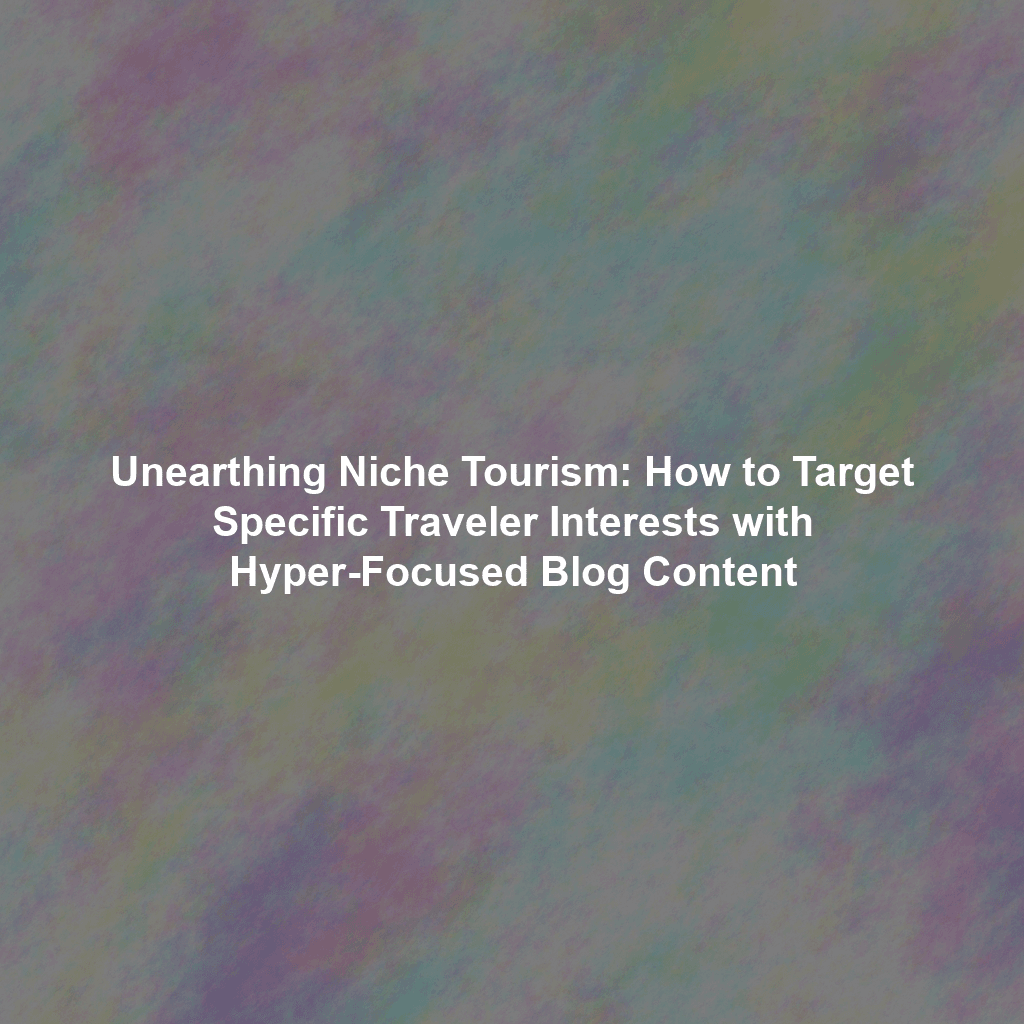The Power of Niche Tourism
Why focus on niches? The answer is simple: relevance. Generic content casts a wide net, often attracting a diluted audience with low intent. Niche content, on the other hand, targets specific interests, attracting travelers who are already highly motivated to explore your destination and participate in related activities. This leads to higher conversion rates, increased engagement, and ultimately, a greater economic impact.
Consider this: a general blog post about “Things to Do in [Your Region]” might attract a few casual visitors. But a blog post titled “The Ultimate Guide to Sustainable Hiking Trails in [Your Region]” will attract eco-conscious hikers actively seeking that specific experience. These hikers are more likely to book accommodations, tours, and other services that align with their values and interests.
Step 1: Keyword Research – Digging for Gold
Before creating any content, thorough keyword research is crucial. You need to understand what your target audience is searching for and the language they use. Here’s how to approach it:
Identifying Relevant Niche Keywords
Start by brainstorming potential niche areas relevant to your destination. Think beyond the obvious. Consider:
- Activity-Based Niches: Rock climbing, bird watching, cycling, kayaking, scuba diving.
- Interest-Based Niches: Culinary tourism (wine tasting, craft beer tours, farm-to-table dining), historical tourism (battlefield tours, architectural landmarks, ancestral research), art & culture (music festivals, galleries, theater).
- Travel Style Niches: Sustainable tourism, family travel, solo travel, luxury travel, budget travel.
Once you have a list of potential niches, use keyword research tools like Google Keyword Planner, SEMrush, Ahrefs, or Moz Keyword Explorer to identify specific keywords and phrases related to each niche. Look for keywords with a good balance of search volume and low competition.
Long-Tail Keywords: The Secret Weapon
Long-tail keywords are longer, more specific phrases that often indicate a higher level of intent. For example, instead of targeting the keyword “hiking trails,” target a long-tail keyword like “best family-friendly hiking trails near [Your City] with waterfalls.” These keywords are easier to rank for and attract a more qualified audience.
Step 2: Content Ideation – Crafting Compelling Stories
With your keyword research in hand, it’s time to brainstorm content ideas that will resonate with your target audience. Focus on creating valuable, informative, and engaging content that answers their questions and inspires them to visit your destination.
Types of Niche Content to Consider
- Ultimate Guides: Comprehensive resources covering everything a traveler needs to know about a specific niche in your destination.
- Itineraries: Detailed itineraries tailored to specific interests, such as a “3-Day Culinary Adventure in [Your Region]” or a “Historical Walking Tour of [Your City].”
- Listicles: “Top 10 Hidden Gems for Bird Watching in [Your Region]” or “5 Must-Try Local Dishes in [Your City].”
- Interviews: Feature local experts, chefs, artists, or historians to provide unique insights and perspectives.
- Case Studies: Showcase successful sustainable tourism initiatives or highlight the positive impact of tourism on local communities.
- Behind-the-Scenes Content: Offer a glimpse into the making of local products, the preparation of regional dishes, or the conservation efforts of your park rangers.
Creating High-Quality Content
Remember to:
- Write for your audience: Use clear, concise language and avoid jargon.
- Provide value: Answer their questions, solve their problems, and offer practical tips.
- Use high-quality images and videos: Visuals are essential for capturing attention and showcasing the beauty of your destination.
- Optimize for SEO: Use your target keywords naturally throughout your content, including in the title, headings, meta description, and image alt text.
- Ensure content is accurate and up-to-date: Regularly review and update your content to maintain its relevance and credibility.
Step 3: Promotion – Getting Your Content Seen
Creating great content is only half the battle. You also need to promote it effectively to reach your target audience.
Social Media Marketing
Share your blog content on social media platforms where your target audience is active. Use relevant hashtags and engage with your followers.
Email Marketing
Build an email list and send out regular newsletters featuring your latest blog posts and other relevant content. Segment your list based on interests to personalize your messaging.
Influencer Marketing
Partner with influencers in your niche to promote your destination and your content. Choose influencers who have a genuine connection with your target audience and whose values align with your brand.
Partnerships
Collaborate with local businesses, tour operators, and other organizations to promote your content to their audiences. Cross-promotion can significantly expand your reach.
Paid Advertising
Consider using paid advertising platforms like Google Ads or social media ads to target specific demographics and interests.
Measuring Success and Adapting
Track your website traffic, engagement metrics, and conversion rates to measure the effectiveness of your niche tourism content strategy. Use Google Analytics and other analytics tools to monitor your progress and identify areas for improvement.
Regularly review your keyword research, content strategy, and promotion efforts. Be prepared to adapt your approach based on the data you collect and the evolving needs of your target audience.
Conclusion
By embracing niche tourism and creating hyper-focused blog content, tourism boards can attract highly engaged visitors, increase their destination’s visibility, and drive economic growth. The key is to understand your target audience, provide valuable content, and promote it effectively. With a strategic approach and a commitment to quality, you can unlock the untapped potential of niche tourism and position your destination as a leader in the travel industry.
 Skip to content
Skip to content

